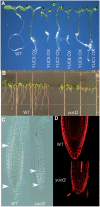Auxin overproduction in shoots cannot rescue auxin deficiencies in Arabidopsis roots
- PMID: 24562917
- PMCID: PMC4051135
- DOI: 10.1093/pcp/pcu039
Auxin overproduction in shoots cannot rescue auxin deficiencies in Arabidopsis roots
Abstract
Auxin plays an essential role in root development. It has been a long-held dogma that auxin required for root development is mainly transported from shoots into roots by polarly localized auxin transporters. However, it is known that auxin is also synthesized in roots. Here we demonstrate that a group of YUCCA (YUC) genes, which encode the rate-limiting enzymes for auxin biosynthesis, plays an essential role in Arabidopsis root development. Five YUC genes (YUC3, YUC5, YUC7, YUC8 and YUC9) display distinct expression patterns during root development. Simultaneous inactivation of the five YUC genes (yucQ mutants) leads to the development of very short and agravitropic primary roots. The yucQ phenotypes are rescued by either adding 5 nM of the natural auxin, IAA, in the growth media or by expressing a YUC gene in the roots of yucQ. Interestingly, overexpression of a YUC gene in shoots in yucQ causes the characteristic auxin overproduction phenotypes in shoots; however, the root defects of yucQ are not rescued. Our data demonstrate that localized auxin biosynthesis in roots is required for normal root development and that auxin transported from shoots is not sufficient for supporting root elongation and root gravitropic responses.
Keywords: Auxin; Biosynthesis; Hormone; Root development; Transport.
© The Author 2014. Published by Oxford University Press on behalf of Japanese Society of Plant Physiologists. All rights reserved. For permissions, please email: journals.permissions@oup.com.
Figures




Similar articles
-
The jasmonic acid signaling pathway is linked to auxin homeostasis through the modulation of YUCCA8 and YUCCA9 gene expression.Plant J. 2013 May;74(4):626-37. doi: 10.1111/tpj.12152. Epub 2013 Mar 25. Plant J. 2013. PMID: 23425284 Free PMC article.
-
Yucasin is a potent inhibitor of YUCCA, a key enzyme in auxin biosynthesis.Plant J. 2014 Feb;77(3):352-66. doi: 10.1111/tpj.12399. Epub 2014 Jan 16. Plant J. 2014. PMID: 24299123
-
Bioinformatics Analysis of Phylogeny and Transcription of TAA/YUC Auxin Biosynthetic Genes.Int J Mol Sci. 2017 Aug 18;18(8):1791. doi: 10.3390/ijms18081791. Int J Mol Sci. 2017. PMID: 28820425 Free PMC article.
-
Molecular genetic analysis of plant gravitropism.Gravit Space Biol Bull. 1997 Jun;10(2):75-82. Gravit Space Biol Bull. 1997. PMID: 11540123 Review.
-
Auxin transport and gravitational research: perspectives.Protoplasma. 2006 Dec;229(2-4):175-81. doi: 10.1007/s00709-006-0216-9. Epub 2006 Dec 16. Protoplasma. 2006. PMID: 17180499 Review.
Cited by
-
Genome-wide identification and expression profiling of the YUCCA gene family in Malus domestica.Sci Rep. 2020 Jul 2;10(1):10866. doi: 10.1038/s41598-020-66483-y. Sci Rep. 2020. PMID: 32616911 Free PMC article.
-
An APETALA2/ethylene responsive factor transcription factor GmCRF4a regulates plant height and auxin biosynthesis in soybean.Front Plant Sci. 2022 Sep 6;13:983650. doi: 10.3389/fpls.2022.983650. eCollection 2022. Front Plant Sci. 2022. PMID: 36147224 Free PMC article.
-
Molecular Evolution and Local Root Heterogeneous Expression of the Chenopodium quinoa ARF Genes Provide Insights into the Adaptive Domestication of Crops in Complex Environments.J Mol Evol. 2021 Jun;89(4-5):287-301. doi: 10.1007/s00239-021-10005-5. Epub 2021 Mar 23. J Mol Evol. 2021. PMID: 33755734
-
Local Auxin Biosynthesis Mediated by a YUCCA Flavin Monooxygenase Regulates Haustorium Development in the Parasitic Plant Phtheirospermum japonicum.Plant Cell. 2016 Aug;28(8):1795-814. doi: 10.1105/tpc.16.00310. Epub 2016 Jul 6. Plant Cell. 2016. PMID: 27385817 Free PMC article.
-
Root cap-dependent gravitropic U-turn of maize root requires light-induced auxin biosynthesis via the YUC pathway in the root apex.J Exp Bot. 2016 Aug;67(15):4581-91. doi: 10.1093/jxb/erw232. Epub 2016 Jun 15. J Exp Bot. 2016. PMID: 27307546 Free PMC article.
References
-
- Benjamins R, Scheres B. Auxin: the looping star in plant development. Annu. Rev. Plant Biol. 2008;59:443–465. - PubMed
-
- Benkova E, Michniewicz M, Sauer M, Teichmann T, Seifertova D, Jurgens G, et al. Local, efflux-dependent auxin gradients as a common module for plant organ formation. Cell. 2003;115:591–602. - PubMed
-
- Birnbaum K, Shasha DE, Wang JY, Jung JW, Lambert GM, Galbraith DW, et al. A gene expression map of the Arabidopsis root. Science. 2003;302:1956–1960. - PubMed
-
- Brunoud G, Wells DM, Oliva M, Larrieu A, Mirabet V, Burrow AH, et al. A novel sensor to map auxin response and distribution at high spatio-temporal resolution. Nature. 2012;482:103–106. - PubMed
-
- Casamitjana-Martinez E, Hofhuis HF, Xu J, Liu CM, Heidstra R, Scheres B. Root-specific CLE19 overexpression and the sol1/2 suppressors implicate a CLV-like pathway in the control of Arabidopsis root meristem maintenance. Curr. Biol. 2003;13:1435–1441. - PubMed
Publication types
MeSH terms
Substances
Grants and funding
LinkOut - more resources
Full Text Sources
Other Literature Sources
Molecular Biology Databases

